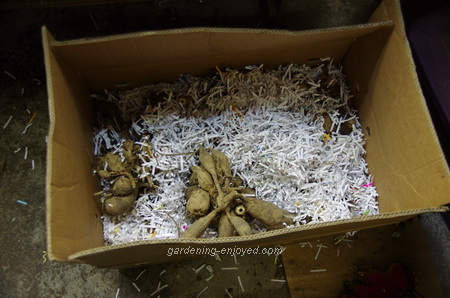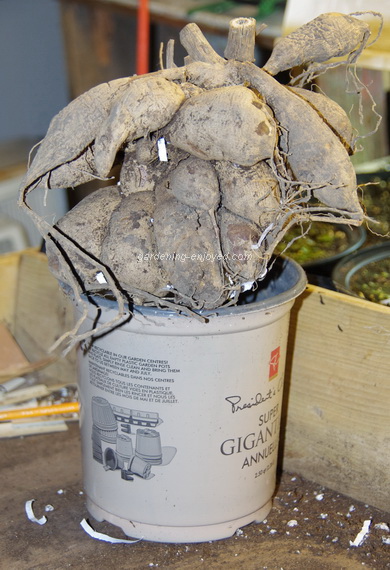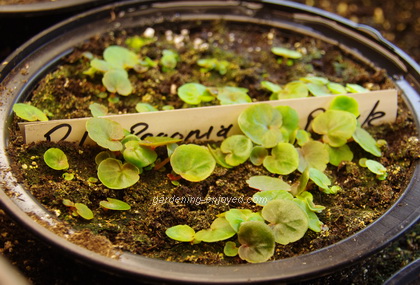
We all have a little shredder in our office to destroy all those bits of paper that carry sensitive information. Gardeners actually have a good use for that shredded paper. I have been digging in my big box of it to find all of the summer flowering bulbs and tubers that have been stored in it all winter. It keeps those tubers, dark, dry and relatively cool; just the conditions they need to have a comfortable winter’s nap. When I empty the box the shredded paper that is left can be used in the garden as a one season mulch. Dahlias, Colocasia and Tuberous Begonias have been sleeping happily in this box and now it is time to get them out and let them find some warm moist soil. Suddenly space becomes a problem. My couple of hundred Begonia seedlings don’t take as much room as half a dozen of these awakening delights. It will be some time before light is critical so I could take them upstairs and spread
them around the floor of the solarium and see what the Assistant Gardener’s reaction is. Maybe it’s time to plug in the heating cable to warm up the outdoor cold frame. There are many large Geraniums under the lights that I really should put into larger pots and then move them to the cold frame as they are not quite as sensitive to the fluctuating temperatures they will find there.
 The problem with keeping tubers from year to year is that they multiply and get bigger. This Dahlia tuber was new last year and I started it in a 10 cm (4") pot. That’s a 20 cm (8") pot that it doesn’t want to fit in. I really want to take advantage of its size to grow a magnificent plant this summer but I have several of a similar size. Even if I can get them potted they will be a problem under the lights. If I raise the lights high enough to put those pots underneath, then the lights will be too high to give the maximum amount of light to the much shorter seedlings that need to share the space. To make them fit into the pot I will remove some of the outer tubers. There are always a few that have partially broken connections or are damaged. After I remove those bits they can probably be squeezed into that pot. I could divide the large clump of tubers to make more plants but Dahlias divisions are very difficult to figure out until they have sprouted so that you can
see where the strongest stems are coming from. I’m not sure I really need two or more of that particular Dahlia. I would rather acquire another variety to squeeze into the limited space in the garden. I’ll pot it up as best as possible and hide it among the big pots of Orchids in the solarium and move it out to the cold frame before anybody notices it.
The problem with keeping tubers from year to year is that they multiply and get bigger. This Dahlia tuber was new last year and I started it in a 10 cm (4") pot. That’s a 20 cm (8") pot that it doesn’t want to fit in. I really want to take advantage of its size to grow a magnificent plant this summer but I have several of a similar size. Even if I can get them potted they will be a problem under the lights. If I raise the lights high enough to put those pots underneath, then the lights will be too high to give the maximum amount of light to the much shorter seedlings that need to share the space. To make them fit into the pot I will remove some of the outer tubers. There are always a few that have partially broken connections or are damaged. After I remove those bits they can probably be squeezed into that pot. I could divide the large clump of tubers to make more plants but Dahlias divisions are very difficult to figure out until they have sprouted so that you can
see where the strongest stems are coming from. I’m not sure I really need two or more of that particular Dahlia. I would rather acquire another variety to squeeze into the limited space in the garden. I’ll pot it up as best as possible and hide it among the big pots of Orchids in the solarium and move it out to the cold frame before anybody notices it.
 I haven’t showed you the how well the fancy Tuberous Begonia seedlings are doing. They are growing quite quickly and it will soon be time to try and separate them and transplant them to larger individual pots. It’s interesting how, in the same batch, some of the seedlings take off and grow at a much faster rate than some others. Obviously I will transplant the biggest ones, partly because they will be much easier to handle and obviously they should be the most vigorous all summer. As much as I try to spread their tiny seeds evenly over the soil you can see that they always wind up clumped together and that is one of the reasons to transplant them now so that they can be more easily untangled and not have to compete with their bed mates. I have a few volunteers to help me with the other problem. There are many more seedlings than I could possibly grow on or use in the garden this summer. That’s a
problem that I’m glad to have and one that’s hard to avoid when dealing with seeds that are size of dust particles.
I haven’t showed you the how well the fancy Tuberous Begonia seedlings are doing. They are growing quite quickly and it will soon be time to try and separate them and transplant them to larger individual pots. It’s interesting how, in the same batch, some of the seedlings take off and grow at a much faster rate than some others. Obviously I will transplant the biggest ones, partly because they will be much easier to handle and obviously they should be the most vigorous all summer. As much as I try to spread their tiny seeds evenly over the soil you can see that they always wind up clumped together and that is one of the reasons to transplant them now so that they can be more easily untangled and not have to compete with their bed mates. I have a few volunteers to help me with the other problem. There are many more seedlings than I could possibly grow on or use in the garden this summer. That’s a
problem that I’m glad to have and one that’s hard to avoid when dealing with seeds that are size of dust particles.
Those of my readers in southern Ontario can get their gardener’s soul nourished at Canada Blooms, the country’s biggest gardening show. It runs from 11 - 20 of March and you can find me there speaking on Monday 14th at noon.
Now it’s time to answer a few of my reader’s questions. Don’t forget to check the front page of the Website for frequent short ideas for current gardening activities.
Sylvia Asks? Help! How do I get my huge Madagascar Cactus to bloom?
Ken Answers! Madagascar Cactus or Palm is actually neither but is Pachypodium lamerei a succulent of the Apocyanaceae family. It will be difficult to bloom indoors unless you can provide it with a lot of sunlight. Consider moving it
outside into full sun for the summer and see if that does it. Will not tolerate any frost so make sure it gets back inside early enough in the fall.
Brenda Asks? I have two Amaryllis bulbs which I kept from last year. One of them did not bloom last year but I kept both bulbs and brought them up from the basement in January. I put them in a south, west facing window where it is warm. They have both developed the healthiest leaves you have seen each being about 2 1/2 feet long. Not only is there no bloom but no stock either. What did I do wrong?
Ken Answers! Reblooming Amaryllis is theoretically easy but doesn't always work in practice. They need to regenerate the bulb in summer. Mine go outside in fairly bright sun and get fertilized about every two weeks. When they come inside in the fall they are allowed to go completely dry and dormant and they are kept in a dark, cool 50 -
55F place. They stay dormant for 2 - 4 months and they come upstairs. Lack of sun, fertilizer, or cool period can cause them not to bloom. Some will grow those lovely leaves for awhile and then bloom.
Valerie Asks? I am planning to remove most of my flowers in the back of my garden and plant vegetables. Can you please give me some information on what is best to plant that will not be eaten by rabbits or squirrels as soon as they appear out of the ground.
Ken Answers! There isn't much that rapacious rabbits won't eat. Squirrels are actually much less of a problem, they tend not to like green leafy things. It's easier to stop rabbits than plant things they won't eat. I have put a simple 30" wire fence around a big section of my garden and that seems to deter them. The vegetables that I grew in Earth boxes were not bothered, the rabbits don't seem to like anything that they have to climb for. I suspect that raised beds if they were at least
12" off the ground. might have the same effect. They love peppers and beans and most cabbage family crops but seemed to ignore the Tomatoes and carrots, (despite the Bugs Bunny Cartoons.) Vine types such as cukes, squash, zucchini also don't seem to appeal to them.
Have fun and good luck. Keep a Jack Russell terrier in the back yard, that works well:-)
|

 The problem with keeping tubers from year to year is that they multiply and get bigger. This Dahlia tuber was new last year and I started it in a 10 cm (4") pot. That’s a 20 cm (8") pot that it doesn’t want to fit in. I really want to take advantage of its size to grow a magnificent plant this summer but I have several of a similar size. Even if I can get them potted they will be a problem under the lights. If I raise the lights high enough to put those pots underneath, then the lights will be too high to give the maximum amount of light to the much shorter seedlings that need to share the space. To make them fit into the pot I will remove some of the outer tubers. There are always a few that have partially broken connections or are damaged. After I remove those bits they can probably be squeezed into that pot. I could divide the large clump of tubers to make more plants but Dahlias divisions are very difficult to figure out until they have sprouted so that you can
see where the strongest stems are coming from. I’m not sure I really need two or more of that particular Dahlia. I would rather acquire another variety to squeeze into the limited space in the garden. I’ll pot it up as best as possible and hide it among the big pots of Orchids in the solarium and move it out to the cold frame before anybody notices it.
The problem with keeping tubers from year to year is that they multiply and get bigger. This Dahlia tuber was new last year and I started it in a 10 cm (4") pot. That’s a 20 cm (8") pot that it doesn’t want to fit in. I really want to take advantage of its size to grow a magnificent plant this summer but I have several of a similar size. Even if I can get them potted they will be a problem under the lights. If I raise the lights high enough to put those pots underneath, then the lights will be too high to give the maximum amount of light to the much shorter seedlings that need to share the space. To make them fit into the pot I will remove some of the outer tubers. There are always a few that have partially broken connections or are damaged. After I remove those bits they can probably be squeezed into that pot. I could divide the large clump of tubers to make more plants but Dahlias divisions are very difficult to figure out until they have sprouted so that you can
see where the strongest stems are coming from. I’m not sure I really need two or more of that particular Dahlia. I would rather acquire another variety to squeeze into the limited space in the garden. I’ll pot it up as best as possible and hide it among the big pots of Orchids in the solarium and move it out to the cold frame before anybody notices it. I haven’t showed you the how well the fancy Tuberous Begonia seedlings are doing. They are growing quite quickly and it will soon be time to try and separate them and transplant them to larger individual pots. It’s interesting how, in the same batch, some of the seedlings take off and grow at a much faster rate than some others. Obviously I will transplant the biggest ones, partly because they will be much easier to handle and obviously they should be the most vigorous all summer. As much as I try to spread their tiny seeds evenly over the soil you can see that they always wind up clumped together and that is one of the reasons to transplant them now so that they can be more easily untangled and not have to compete with their bed mates. I have a few volunteers to help me with the other problem. There are many more seedlings than I could possibly grow on or use in the garden this summer. That’s a
problem that I’m glad to have and one that’s hard to avoid when dealing with seeds that are size of dust particles.
I haven’t showed you the how well the fancy Tuberous Begonia seedlings are doing. They are growing quite quickly and it will soon be time to try and separate them and transplant them to larger individual pots. It’s interesting how, in the same batch, some of the seedlings take off and grow at a much faster rate than some others. Obviously I will transplant the biggest ones, partly because they will be much easier to handle and obviously they should be the most vigorous all summer. As much as I try to spread their tiny seeds evenly over the soil you can see that they always wind up clumped together and that is one of the reasons to transplant them now so that they can be more easily untangled and not have to compete with their bed mates. I have a few volunteers to help me with the other problem. There are many more seedlings than I could possibly grow on or use in the garden this summer. That’s a
problem that I’m glad to have and one that’s hard to avoid when dealing with seeds that are size of dust particles.